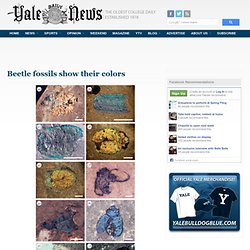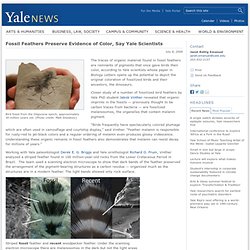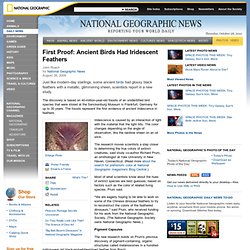

Fossil Moth Reveals Colorful Hue. Beetle fossils show their colors. The fossils of beetles may open the door to understanding what exactly ancient organisms looked like.

Maria McNamara, a postdoctoral fellow in the Yale Department of Geology and Geophysics, used fossilized beetles to show how colors of insects have changed over time, adding to scientists’ understanding of ancient insects’ appearance. McNamara, with help from her colleagues at the Peabody Museum, the Department of Applied Physics and University College Dublin, studied the cuticles of fossilized beetle remains ranging from 15 million to 47 million years old. Using electron microscopy, McNamara saw that the metallic colors of beetles was altered, demonstrating that fossilization changed the metallic color of the beetle. The hue of a beetle depends on refraction of light within its exoskeleton. According to the study, the chemical makeup of the exoskeleton of the insect bends light waves to produce a metallic color. “The big question is, how far can we extend this scenario?” Prehistoric Colors Preserved in Near-Perfect Beetle Fossils. Leaf Beetle, MesselFrom the fossil pits in Messel, Germany.

Approximately 47 million years old. Leaf Beetle, Messel (Microscope View)Scanning electron microscope view of the beetle's shell. The arrow points to a pore. Scale bar corresponds to 2 micrometers in length. Fossil Feathers Preserve Evidence of Color, Say Yale Scientists. Bird fossil from the Oligocene epoch, approximately 30 million years old.

[Photo credit: Matt Shawkey] The traces of organic material found in fossil feathers are remnants of pigments that once gave birds their color, according to Yale scientists whose paper in Biology Letters opens up the potential to depict the original coloration of fossilized birds and their ancestors, the dinosaurs. Closer study of a number of fossilized bird feathers by Yale PhD student Jakob Vinther revealed that organic imprints in the fossils — previously thought to be carbon traces from bacteria — are fossilized melanosomes, the organelles that contain melanin pigment. “Birds frequently have spectacularly colored plumage which are often used in camouflage and courtship display,” said Vinther. “Feather melanin is responsible for rusty-red to jet-black colors and a regular ordering of melanin even produces glossy iridescence. Working with Yale paleontologist Derek E.
Citation: Biol.Lett. Dinosaur True Colors Revealed for First Time by Feather Study. Pigments have been found in fossil dinosaurs for the first time, a new study says.

The discovery may prove once and for all that dinosaurs' hairlike filaments—sometimes called dino fuzz—are related to bird feathers, paleontologists announced today. (Pictures: Dinosaur True Colors Revealed by Feather Find.) First Proof: Ancient Birds Had Iridescent Feathers. August 26, 2009 Just like modern-day starlings, some ancient birds had glossy black feathers with a metallic, glimmering sheen, scientists report in a new study.

The discovery is based on 40-million-year-old fossils of an unidentified bird species that were stored at the Senckenburg Museum in Frankfurt, Germany for up to 30 years. The fossils represent the first evidence of ancient iridescence in feathers. What Color Is Your Dinosaur? The Dragons of Liaoning. Paleontologists are always looking for vast new caches of clues about ancient life but rarely expect to find them.

Fossil discoveries tend to come piece meal, one fragment at a time, so we were unprepared for the onslaught of fossils from Liaoning Provincein northeastern China. The story began in the early 1990s, when Chinese researchers began unearthing intriguing land animals: first a primitive toothed bird, then a more advanced one. Then rumors began to circulate about strange dinosaurs covered with birdlike feathers. Now it seems as if there are more kinds of these creatures than we can count.
Dinosaurs everywhere have been reevaluated, even to the extreme of considering that such familiar ones as Tyrannosaurus rex were probably feathered, at least for part of their lives. During the Early Cretaceous, between 110 million and 140 million years ago, Liaoning was a remarkable place—covered by forests, riddled with lakes, and populated with a rich variety of animal and plant life. Feathers Trapped in Amber Reveal a More Colorful Dinosaur Age. Evolution of Feathers.
First Dinosaur Feathers for Show, Not Flight? October 22, 2008 One of the oldest known dinosaur relatives of birds had "bizarre" anatomy, including long, ribbon-like tail feathers that suggest plumage may have first evolved for show rather than for flight, scientists say.

Farmers unearthed a fossil of the new dino species, dubbed Epidexipteryx hui, from the hills of Inner Mongolia in late 2007. The remains date back to 152 million to 168 million years ago, making the newfound creature slightly older than Archaeopteryx, the most primitive known bird. (Related: "Earliest Bird Had Feet Like Dinosaur, Fossil Shows" [December 1, 2005].) Like other avialans—birds and their closest dinosaur relatives—Epidexipteryx is a theropod, a group of two-legged animals that includes Tyrannosaurus rex. Researchers think the pigeon-size Epidexipteryx might have used its plumes as flashy ornaments, since it was mostly covered in short feathers that lack the structure necessary for flight.
"Bizarre" Anatomy. Amber Reveals Origins of Feathers. Dinosaur feather evolution trapped in Canadian amber.